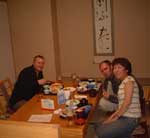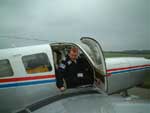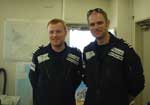

75
DAYS TO GO
![]()
DONATE
| HOME |
| DIARY |
| ROUTE |
| SPONSORS |
| PRESS ROOM |
| BREMEN FLIGHT |
| CHARITY |
| THE AIRCRAFT |
| THE PILOTS |
| CONTACT US |
© Copyright World Flight 2002-2003
| June 22 Akita, Japan to Adak, Alaska The day started early with a 7am wake up call at Akita. We headed to the airport with Ms Soko Namba, our clearance agent in Japan. Thanks to Ms Namba for making our visit through Japan so easy and at a very favorable rate. If you are planing to fly to Japan contact Ms Namba for advice and details, tas@tango-air-support.com Our plan was to fly to Memanbetsu Airport which is in North Japan, to land and refuel our ferry tank and main tanks to the maximum for the long Pacific flight. We would have 234 Gallons onboard for the flight. We had to make our decision to go and attempt the Pacific crossing at Akita airport as there was no Customs or Immigration in Memanbetsu. At Akita airport we divided the pre planning work. Paul looked after the flight plan while Alan assembled the weather and studied the forecast to see if we had the right winds and weather to make the flight that day. Our first problem came about when our flight plan route was not accepted. Due to poor HF coverage over the Pacific, Tokyo control would not let us go direct to Adak but only to follow the approved airway route which increased the distance to over 1950 miles. At this distance we could not make it with the fuel we had onboard. Eventually Paul got speaking to Anchorage control and they approved our route direct to Adak from the Japan/Alaska boundary. This brought our distance down to 1840 miles (still 100 miles more than our original planned route but with the right winds we would make it!). At the same time Alan gathered together as much weather information as he could get his hands on from the weather office. The problem being, the weather office did not have any information on international weather, only for Japanese weather, this left us none the wiser as to the wind direction and strength over the Pacific. We had weather access from our Jepessen flight planning program but without phone coverage in Japan we could not access this either. Thanks to the very helpful staff at the briefing office in Akita airport as they were able to let us onto their computer network to access weather. From our interpretation the weather looked ok to go, but marginal. A low pressure system was sitting of the coast of Japan and moving south east, resulting in what looked like 15-20knot headwinds for the first couple of hours of our flight. After flying north east for a number of hours the Synoptic chart showed we would be flying into a High pressure system stationery over the North Pacific. This High pressure should reduce any headwind and possibly even give us tailwinds as we approached Adak island. We could either go now and accept some headwinds but be assured that as there was a High pressure for much of our route the weather would be stable and safe or we could wait a few days for the regular fronts to appear again and follow a cold front which would ensure strong tailwinds (20-30knots are the norm) which would speed up our flight across the Ocean but bringing with the cold front, more uncertain weather on route. A decision was made to go. We calculated we could still make Adak with the fuel we had onboard even with a 15 knot headwind but any more headwind and we would not have enough fuel. Leaving Akita (RJSK) at 3pm local time we took off with our main tanks full (84 Gallons) and 120 Gallons in our ferry tank. Our flight to Memanbetsu (RJCM) went smoothly with beautiful scenery on route. The main thing that comes to mind about Japan is the high terrain and rugged countryside. On landing at Memanbetsu we topped up all fuel tanks (234 Gallons) to give us maximum fuel for the long Pacific leg. Departing Memanbetsu at last light, we flew initially South on climb to 7,000 feet following the airway. South was not the direction we wanted to go but essential to avoid entering Russian airspace. Even though the aircraft was the heaviest she had been during World Flight 2003 she climbed very nicely, helped by the cooler night air. After 60 miles we left Japan and headed out over the sea to the north east. Our transponder stopped flashing indicating that Tokyo control had lost radar coverage of our aircraft as we headed outside their radar coverage area. The only record of our position would now be by position reports made to Tokyo on long range HF radio (using our 70 metre aerial trailing behind the aircraft) . In the event of an emergency we would put a mayday out on HF with out longitude and latitude for search and rescue to come and find us. Flying out to sea in the dark was an experience; we had done only a couple of night flights so far on the trip so to fly through the night into the next day would be a new experience. Dawn broke near the waypoint "Nippi" (N 49° 42.60' E159° 20.80') which was the border of Japanese airspace and Anchorage/Alaska airspace. Headwinds reduced to 10 knots and our updated fuel calculation at the boundary Nippi showed we should make Adak with 1hr of fuel remaining onboard. Our HF communications was not working properly for both of us so Alan took over monitoring the HF radio and passing position reports while Paul monitored on VHF 121.5 the emergency frequency. HF radio was busy with airliners crossing the Pacific from America. A notable HF radio period was when we heard a two US airforce air refueler aircraft somewhere over the Pacific, call signs Petro One and Petro Two. They were asked by Air Traffic Control how many other aircraft were in formation and the replay was "nine chicks" - nine fighter aircraft with the two fuel tanker aircraft heading south west. We reckoned the fighters were going long range and the tankers were with them to keep them topped up with fuel along the way. One difficulty of the 15 hours flight was staying awake. We took turns to take naps while the other flew the aircraft and monitored the radio. The dangerous aspect of a long flight could be seen as tiredness set in, especially when one of us was asleep and the radio was quiet it is very easy for the person flying to find their eyes closing, a freighting experience when you think both of you could have easily nodded off (especially as we do not have an altitude hold autopilot). Both of us had our own ways of keeping awake, checking the instruments or even singing works… Closing in on Adak we were happy to see our fuel calculations work out in our favor with estimated 1hr 40mins remaining on landing as the headwind had now become a tailwind. Over the Aleutian Islands we were surprised to see so much high terrain, mountains rising out of the sea up to 5,000 feet. The weather at Adak was not great, with low cloud and gusting winds but Adak was our only choice for landing. We got a weather report and made our Instrument approach into Adak touching down at 4pm local time on Sunday 22nd (as we had crossed the date line we gained a day on this flight and ended up landing before we took off Sunday 22nd 8pm). Taxing to park we were happy to be back on the ground and to have successfully crossed the 1840 nautical miles of the Pacific Ocean in our single engine Piper Cherokee Six. Climbing out of the aircraft was not easy after the long flight and we pulled off our life jackets, immersion suits and then quickly got out jackets back on as it was cold at 6 degrees with drizzle and mist on the surrounding mountains, very different weather to warm Japan. The longest and most dangerous flight of World Flight 2003 was over, it felt really good to have crossed the |Pacific safe and sound. |
|





